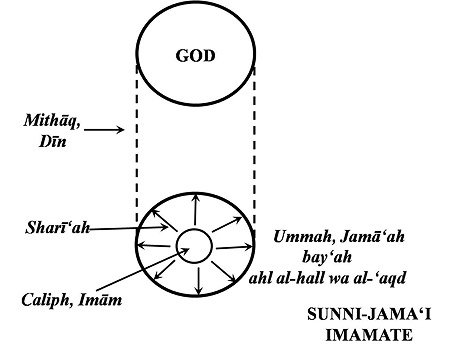Image Resource Bank
Image Gallery |  2 of 15
2 of 15 
The Sunnī-Jamā‘ī Imamate
The Sunnī Jamā‘ī Imamate necessarily departs from the utopian Medinan community due to the absence of the Prophet. At the center is Muhammad’s deputy and successor (khalīfah/caliph), who is also the commander of the faithful (amīr al-mu’minīn), and the leader of the ummah (imām). Unlike Muhammad, the caliph-imām is not the recipient of divine revelation, and he is not infallible in his personal moral conduct. However, his authority is unique: in addition to being the administrative head of state and chief commander of the military, he is also the foremost arbiter in the discernment of sharī‘ah and responsible for the implementation of Islamic law. In this system, the relationship between God and the ummah is defined by mīthāq (“covenant,” Q 7:172 mentioned above), which is the foundation of dīn, the religious tradition (Islam) inaugurated by the covenant. The members of the community have sworn an oath of allegiance (bay‘ah) to the caliph-imām, which ratifies his authority. A check on the power of the caliph-imām resides in the hands of certain members of the community known as ahl al-hall wa al-‘aqd (literally “the people qualified to unbind and bind”). In theory, the ahl al-hall wa al-‘aqd are representatives within the ummah who act on behalf of all Muslims in appointing and deposing a caliph-imām. In practice, throughout the history of Islamic civilization, “they have consisted of the persons who wielded political power in the capital, acting in association with urban notables and prominent religious scholars.”
Name: The Sunnī-Jamā‘ī Imamate
Material: JPEG image
Size: 1314 x 988 pixels
Date: 2009
Place of Origin: University of Chicago
Location: Chicago, IL
Source and Registration#: Professor John E. Woods

 John Woods
John Woods
Professor of Iranian and Central Asian History, and of Near Eastern Languages & Civilizations
 Alexander Barna
Alexander Barna
Outreach Coordinator, Center for Middle Eastern Studies, University of Chicago




